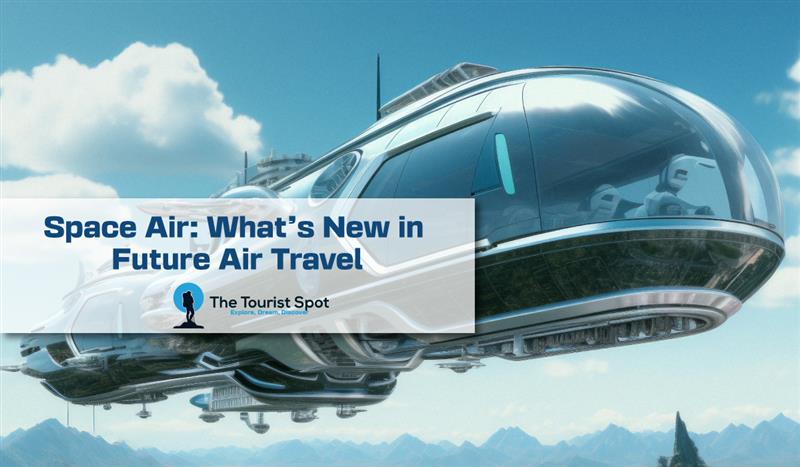The aviation industry is on the verge of a remarkable transformation. As we look toward the future of travel, a new term is capturing the world’s imagination—Space Air. This futuristic concept blends high-altitude air travel with elements of space technology, bringing us closer to faster, cleaner, and more advanced ways to explore the skies and beyond.
Whether it’s ultra-high-speed flights, space tourism, or zero-emission aircraft, Space Air is not just a vision—it’s becoming a reality. Here’s a closer look at what’s changing in air travel and how Space Air is set to redefine our global mobility by 2025 and beyond.
What Is Space Air?
Space Air refers to a new generation of air travel that incorporates cutting-edge aerospace technologies, including suborbital flight, space tourism, and high-speed air transportation. Unlike traditional airliners, these advanced systems aim to reduce travel time dramatically while offering new travel experiences such as leaving Earth’s atmosphere temporarily before descending at another location on the planet.
Space Air is more than a buzzword. It represents the intersection of aviation and spaceflight, powered by innovations from both private companies and government agencies.
1. Suborbital Flights for Faster Travel
One of the biggest breakthroughs in Space Air is the development of suborbital flights. These journeys briefly exit Earth’s atmosphere before re-entering, enabling travel between distant cities in a fraction of the time. For instance, a flight from New York to Tokyo could take under two hours using space air technology.
High-altitude flights that reach near-space altitudes reduce air resistance, allowing aircraft to achieve faster speeds with improved fuel efficiency. While these concepts are still being tested, the future of ultra-fast, point-to-point travel is closer than ever.
2. Space Tourism: The New Frontier
Space Air also includes commercial space tourism, where passengers can experience weightlessness and see Earth from space. Companies are already developing spacecraft that take travelers on brief journeys above the Kármán line—the boundary of outer space.
This form of luxury travel appeals to adventurous individuals and paves the way for greater interest in space exploration and innovation. Though costly now, advancements in technology and competition could make these experiences more accessible in the future.
3. Sustainable Technologies and Green Innovations
Another key aspect of Space Air is sustainability. As environmental concerns grow, aerospace companies are working on electric, hydrogen-powered, and hybrid aircraft that align with green aviation goals.
Future air travel will focus on reducing carbon emissions, noise pollution, and fuel consumption. Space Air solutions are expected to include:
- Electric propulsion systems
- Sustainable aviation fuels (SAFs)
- Lightweight materials for efficient design
These innovations help minimize environmental impact while supporting long-distance and high-altitude travel.
4. Autonomous and AI-Powered Aircraft
Automation is playing a major role in the evolution of Space Air. AI-driven flight systems, auto-pilot innovations, and smart navigation tools will make flying more accurate and safer. Autonomous aircraft are being designed for both cargo and passenger transport, cutting down operational costs and increasing efficiency.
Passengers may soon travel in self-flying jets or shuttles that require minimal human control, making flights smoother and more responsive to dynamic conditions.
5. High-Tech Airport Infrastructure
To support the rise of Space Air, airports and transportation hubs are also evolving. New infrastructure will cater to vertical takeoff and landing (VTOL) aircraft, launch vehicles, and high-speed transit systems. Expect spaceports, AI-powered security, and biometric check-ins to become more common by 2025.
Travelers will experience faster boarding, seamless transitions, and more personalized services, enhancing the overall journey from check-in to landing.
6. Commercial and Scientific Applications
SpaceAir will benefit more than just vacationers. Businesses, researchers, and emergency services can use high-speed air and space transport for urgent missions, cargo delivery, and global communication.
Medical supplies, satellites, and data can be transported across the world at record speed, creating new economic and scientific opportunities. Remote areas will also gain better connectivity, promoting equality in access to technology and services.
7. Challenges and Considerations
While the promise of SpaceAir is exciting, several challenges remain:
- Safety regulations and testing requirements
- High initial costs of development and travel
- Public acceptance and education about new technologies
- Environmental concerns about space debris and atmospheric impact
Still, with ongoing investment, collaboration, and innovation, many of these hurdles are being addressed actively.
Looking Ahead: The Future of Travel
By 2025 and beyond, SpaceAir may become a standard part of our travel vocabulary. As air and space technologies continue to merge, travelers will enjoy experiences that were once only science fiction.
Imagine boarding a jet that reaches the edge of space, sipping your favorite beverage while looking down at Earth, and arriving on another continent in less time than it takes to watch a movie. That is the vision SpaceAir aims to bring to life.
Final Thoughts
The evolution of air travel is entering an exciting phase. Space Air is not just a futuristic concept but a growing industry built on innovation, sustainability, and the dream of global and interstellar connection. From suborbital flights to AI-powered jets, the world of travel is about to become faster, cleaner, and more adventurous.
For eco-conscious travelers, tech enthusiasts, and curious explorers, the skies—and space—are no longer the limit. Get ready to embrace a new era where the next destination might just be above the clouds and beyond.

